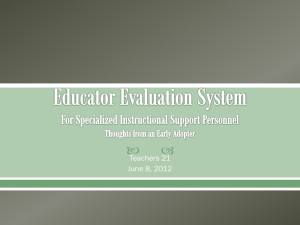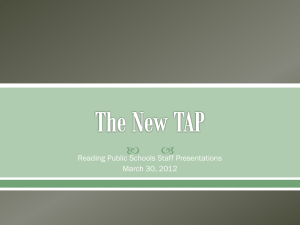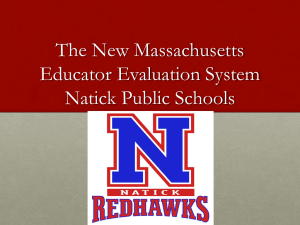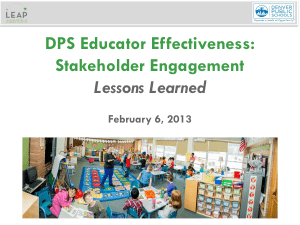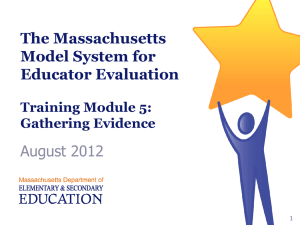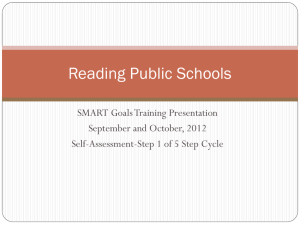MA Model System Training Module 4 Presentation
advertisement
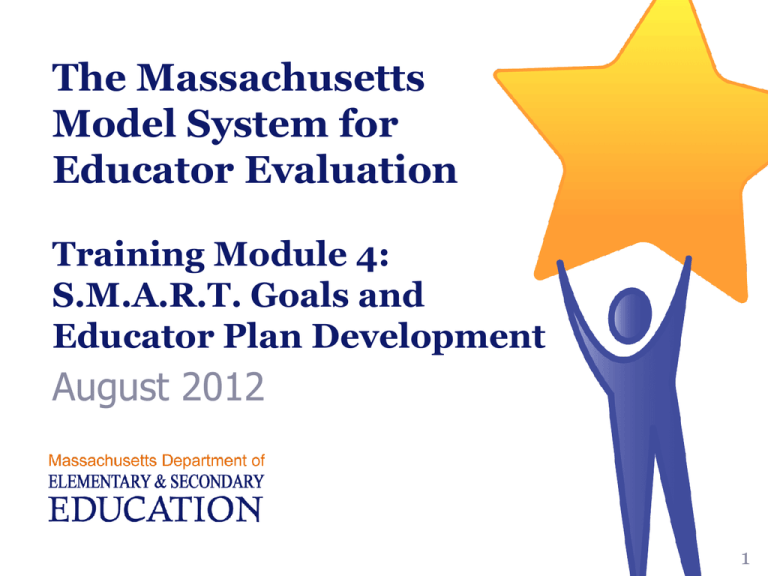
The Massachusetts Model System for Educator Evaluation Training Module 4: S.M.A.R.T. Goals and Educator Plan Development August 2012 1 Module 4: S.M.A.R.T. Goals and Educator Plan Development Module 1: Overview Module 2: Unpacking the Rubric Module 3: Self-Assessment Module 4: S.M.A.R.T. Goals and Educator Plan Development Module 4 focuses on establishing S.M.A.R.T. student learning and professional practice goals. These goals will be part of Educator Plans that are action oriented and have clear benchmarks for success, including provisions for professional development and support. Module 5: Gathering Evidence Module 6: Observations and Feedback Module 7: Rating Educator Performance Module 8: Rating Impact on Students Massachusetts Department of Elementary and Secondary Education 2 Agenda Connecting Learning Implementing Reflecting Wrap-Up 3 Massachusetts Department of Elementary and Secondary Education Connecting 17 minutes 4 Massachusetts Department of Elementary and Secondary Education Every educator is an active participant in the evaluation process. Every educator conducts an analysis of evidence of student learning, growth, and achievement. Every educator conducts an assessment of practice against Performance Standards. Every educator prepares to strategically identify professional practice and student learning goals. 5 Collaboration and continuous learning are the focus. Massachusetts Department of Elementary and Secondary Education Intended Outcomes At the end of this session, participants will be able to: Identify characteristics of “not-so-S.M.A.R.T.,” “S.M.A.R.T.,” and “S.M.A.R.T.er” goals. Translate student learning and professional practice goals into S.M.A.R.T.er goals. Develop a sample Educator Plan that describes what the educator and evaluator will do, support that will be provided, and timelines. Massachusetts Department of Elementary and Secondary Education 6 7 Massachusetts Department of Elementary and Secondary Education Blazing a Trail Identify a challenging goal one team member has accomplished and is willing to discuss. Talk with your school team: 1. Did that person set the goal or did someone (doctor, partner, friend) set the goal for that person? How did that make a difference? 2. What plans did that person make to accomplish the goal? 3. What obstacles surfaced? 4. What was the outcome or result? Identify a recorder to write down the answers to these questions. Massachusetts Department of Elementary and Secondary Education 8 Learning 1 hour 40 minutes 9 Massachusetts Department of Elementary and Secondary Education 10 Massachusetts Department of Elementary and Secondary Education Step 2: Goal setting and plan development facilitates a process that… Promotes professional growth and continuous learning by empowering educators and by meeting real needs of the educator and his or her students. Establishes a plan for every educator that emphasizes continuous improvement. Keeps student learning at the core of all instructional and professional practice decisions. Massachusetts Department of Elementary and Secondary Education 11 Coherence Through Aligned Goals 12 Massachusetts Department of Elementary and Secondary Education An Example of Goal Coherence Dan, a ninth-grade biology teacher: Level Goal Topic School Improvement Literacy Grants focus topic Individual student learning goal topic Scientific reading and writing Team professional practice goal topic Teaching content literacy in ninthgrade science Massachusetts Department of Elementary and Secondary Education 13 S.M.A.R.T. Goals S = Specific and Strategic M = Measurable A = Action Oriented R = Rigorous, Realistic, and Results Focused (the 3 Rs) T = Timed and Tracked 14 Massachusetts Department of Elementary and Secondary Education What Makes a Goal “S.M.A.R.T.”? Individually: Read Handout 1, What Makes a Goal “S.M.A.R.T.”? Underline one phrase that you find most significant in the reading. At your table: Share your phrases. Discuss the phrases that emerged and any insights about the document. Identify one phrase as a table that you will share with the larger group. Massachusetts Department of Elementary and Secondary Education 15 Identifying S.M.A.R.T. Goals I will improve student outcomes in Grade 4 mathematics during the 2012–13 school year. –Teacher Level During the 2012–13 school year, our beginner ELL students will improve their English language proficiency as measured by a second administration of the district language proficiency assessment used to determine student placement at the beginning of the year. –Team Level To increase my staff’s use of student data, I will design meetings to review, analyze, and interpret student data to inform curriculum and instruction. –Administrator Level I will manage my time more effectively in order to increase the frequency of classroom observations. –Administrator Level Work with a partner. Determine if each of the four statements on Handout 2 are S.M.A.R.T. or if they need revision. Revise one statement to make it S.M.A.R.T.er. Massachusetts Department of Elementary and Secondary Education 16 17 Massachusetts Department of Elementary and Secondary Education Making a S.M.A.R.T. Goal S.M.A.R.T.er S.M.A.R.T. Goal Statement + Key Action Steps + Benchmarks (Process and Outcome) 18 Massachusetts Department of Elementary and Secondary Education Educator Plan Development Educator Plan Form Student Learning Goal(s) and Professional Practice Goal(s) Planned Activity Action Supports/Resources From School/District Timeline/Benchmark or Frequency 19 Massachusetts Department of Elementary and Secondary Education Principal Educator Plan Example Sample Professional Practice Goal for a Principal: I will manage my time more effectively in order to increase the frequency and impact of classroom observations by learning how to do 10minute observations with feedback and, by the start of the second semester, conducting eight visits per week, on average, that an increasing percentage of teachers report are useful. Student Learning Goal(s) and Professional Practice Goal(s) Planned Activity Action Supports/ Resources From School/District Timeline/Benchmark or Frequency 1. By September 1, I will develop a schedule and method for logging at least eight classroom observations with feedback per week between October 15 and Memorial Day. 2. By October 15, I will study with colleague principals and my administrative team how to conduct 10-minute unannounced observations and write brief, useful feedback. 3. By January 1, I will share at least five samples of feedback with colleague principals and collect their feedback. 4. By January 1 and again on June 1, I will solicit anonymous feedback from teachers about their perceptions of the usefulness of the unannounced visits and feedback. Superintendent to facilitate teams of principals to collaborate on enhancing the observation and feedback process. Superintendent will help identify teams and provide scheduled time to hold study groups and conduct feedback sessions. 1. September 1—schedule developed January 15/March 15/May 15—check in to determine if eight observations per week (on average) have been completed 2. October 15—documented study time with colleague 3. January 1—five feedback samples will be shared with colleagues 4. January 1 and June 1—will have collected feedback via teachers regarding their perceived value of the process *Evidence provided through principals’ logs and example artifacts Massachusetts Department of Elementary and Secondary Education 20 Process and Outcome Benchmarks Process benchmarks—monitor plan implementation o January 15/March 15/May 15—check in to determine if eight observations per week (on average) have been completed Outcome benchmarks—monitor effectiveness of the plan o January 1 and June 1—will have collected feedback via teachers regarding their perceived value of the 21 process Massachusetts Department of Elementary and Secondary Education Four Types of Educator Plans Developing Educator Plan For educators without Professional Teaching status, administrators in the first three years in a district, or at the discretion of an evaluation for an educator in a new assignment Self-Directed Growth Plan For experienced educators rated Proficient or Exemplary on their last evaluation; these plans can be one or two years in length Directed Growth Plan For educators rated Needs Improvement on their last evaluation Improvement Plan For educators rated Unsatisfactory on their last evaluation Massachusetts Department of Elementary and Secondary Education 22 Educator Plans: Requirements and Timelines Self-Directed Growth Plan Rated Proficient or Exemplary Directed Growth Plan Rated Needs Improvement Improvement Plan Rated Unsatisfactory Developing Educator Plan Without Professional Status One- or two-year plan Developed by the educator One-year plan or less Developed by educator and evaluator At least 30 calendar days; up to one year Developed by the evaluator One-year plan or less Developed by the educator and evaluator 23 Massachusetts Department of Elementary and Secondary Education Implementation Responsibility Educator Responsibilities: o Identifying, collecting & organizing artifacts/evidence related to goal progress. o Documenting action steps completed. o Collecting and submitting common artifacts. o Collecting and submitting evidence related to Standards III and IV. Evaluator Responsibilities: o Making resources and supports available. o Identifying common artifacts/evidence. o Observing practice and providing regular and specific feedback on performance. 24 o Monitoring progress – including midpoint check-ins. Laying the Foundation 1. School teams will work together to develop a completed educator plan. 2. As a team, action steps will be identified. 3. Merge these activities into one Educator Plan that addresses each of the two goals in a strategic, coherent manner. Then document the needed supports and resources and determine a timeline. Student Learning Goal(s) and Professional Practice Goal(s) Planned Activity Action Supports/Resources From School/District Timeline/Benchmark or Frequency Massachusetts Department of Elementary and Secondary Education 25 High-Quality Educator Plans As you walk around and read the other plans, consider the following questions: Are supports/resources identified and strategically leveraged across goals? Is a timeline and frequency of key benchmarks specified? Are action steps specific and sequential? 26 Massachusetts Department of Elementary and Secondary Education Implementing 50 minutes 27 Massachusetts Department of Elementary and Secondary Education Implementation Planning Read Handout 5, Conditions for Readiness, an excerpt from Part II: School-Level Planning and Implementation Guide. o Underline key phrases and concepts. How would you rank these three components in order of importance at your school? What will you need to focus on from the standpoint of facilitating implementation of Step 2 this year? Massachusetts Department of Elementary and Secondary Education 28 Coherence Through Aligned Goals 29 Massachusetts Department of Elementary and Secondary Education Team Goal Setting Districts that prioritize focus areas and support team goals have found this work more “doable” Capitalizes on target Indicators and elements Tips and strategies: o Support regular team time o Identify shared process and benchmark outcomes o Example: new curriculum frameworks—team goal, different roles Massachusetts Department of Elementary and Secondary Education 30 Creating a Through Line District School Educator Teams District Goals/Initiatives School Goals/Initiatives Standards for Effective Teaching Practice Target Indicators Potential Team Goals I. Curriculum, Planning, and Assessment II. Teaching All Students III. Family and Community Engagement IV. Professional Culture Create a through line from district school educator team goals Massachusetts Department of Elementary and Secondary Education 31 Reflecting 5 minutes 32 Massachusetts Department of Elementary and Secondary Education Reflecting Take 5. Jot down your thoughts on the following questions: o Have you been provided the tools to recognize and write high-quality Educator Plans? o What do you foresee as opportunities within the development of Educator Plans? o What do you foresee as challenges in writing/implementing Educator Plans? 33 Massachusetts Department of Elementary and Secondary Education Wrap-Up 5 minutes 34 Massachusetts Department of Elementary and Secondary Education What’s Next? Module 1: Overview Module 2: Unpacking the Rubric Module 3: Self-Assessment Module 4: S.M.A.R.T. Goals and Educator Plan Development Module 5: Gathering Evidence Module 5 focuses on the collection and organization of evidence by Standard and Indicator and engages participants in thinking strategically about gathering high-quality artifacts to demonstrate performance. Module 6: Observations and Feedback Module 7: Rating Educator Performance Module 8: Rating Educator Impact on Students Massachusetts Department of Elementary and Secondary Education 35 Homework 36 Massachusetts Department of Elementary and Secondary Education Suggested Homework for School Leadership Teams As a team, read through the section Considerations for Planning on p. 26 of Part II: School-Level Planning and Implementation Guide. Identify decisions that have been determined and processes already in place, and identify areas in which a process needs to be established in order to coordinate the development of Educator Plans at your school. Draft an action plan that (1) merges existing practices with key practices that need to be established, (2) identifies individual roles and responsibilities associated with each logistical step, and (3) aligns the work to key target dates on a calendar, such that goal setting and Educator Plan development can occur at the appropriate time. Massachusetts Department of Elementary and Secondary Education 37 Suggested Homework for All School-Based Educators Using the Teacher Rubric, work with a colleague in a small group or at a faculty meeting to select a particular Standard, and identify potential sources of evidence (data) to inform performance decisions. Discuss if these data are easily accessible, valid, and comparable across classrooms. 38 Massachusetts Department of Elementary and Secondary Education Feedback and Questions Please take a moment to complete the feedback form being handed out. We appreciate your feedback! Questions? o About this training: E-mail [FACILITATOR/VENDOR EMAIL HERE] o About educator evaluation more generally: E-mail EducatorEvaluation@doe.mass.edu Massachusetts Department of Elementary and Secondary Education 39

